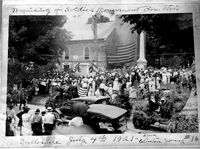Subscriptions
Menu
Advertisements
Schoharie & the Great War Thursday
7/5/2017 |

‘Old Schoharie in the Great War’ will kick off the Schoharie County Historical Society Summer Lecture Series on Thursday, July 6 at 7pm at the Badgley Museum Annex, Old Stone Fort, Schoharie, with Peter Lindemann as presenter.
Mr. Lindemann is a local author and historian.
The lecture is free and open to the public.
“It was one-hundred years ago that America entered the Great War,” said Mr. Lindemann, who has been working on this project for the last six months, “and in Schoharie County we certainly did our bit. Men enlisted, women joined the Red Cross, children became farm cadets, and everyone bought Liberty Bonds.”
After the war, the state historian requested that all town historians submit soldier photographs and reports of town activities so that a record of New York’s role in the war may be published.
The records were submitted but the legislature never funded the project.
The submissions, which remain in boxes in the State Archives in Albany, are a treasure trove of wonderful images and gripping stories, Mr. Lindemann said.
Mr. Lindemann makes use of these images in his PowerPoint presentation, combined with period music, to tell the story of one small county in the Great War.
The grand finale of the program will be a montage of the local soldiers.
One such local soldier is Charles Phincle Rickard.
Born in Schoharie in 1894, he saw service with the National Guard on the Mexican border 1916-1917, then was drafted into Federal service, serving overseas for 10 months during World War One.
Mr. Rickard survived the war and died in Tempe, Arizona in 1961.
Mr. Rickard kept a diary of his war experiences, which was later transcribed and submitted, along with his photograph, to the state historian, and is here abridged:
“Left Newport News, on the President Grant, May 10, 1918. Arrived in Brest, France, May 30…drew gas masks, helmets, also 84 mules and 2 saddle horses, also 14 machine guns, ten limbers (gun mounts), and rolling kitchen. Left St. Formin June 18 and hiked to Routhaville; ate dinner on the road. Machine gun practice daily. Received gas all O.K.
“Got paid, everybody celebrating…at Laclote we had our first casualties, – Ed. Broderick – was shot in back by M.G. (machine gun) bullet while setting up M.G. The following morning little Steven Petro was buried alive. Could hardly be recognized. He was in a dugout where a 9 point two struck it square.
“There was also five English in the dugout…G. Smith was hit in the back by a piece of shrapnel. His overcoat saved his life…Sept 27 – 106 and 105th went over for a few hundred yards. Jerry counter attacked, gets 200 yards. Our boys go over again for a gain of 400 yards, total 500 yards.
“This was to straighten our lines and have a better jumping off place for the Big Drive…Jerry still shelling, too hot for comfort. Pass-word No Prisoners. We met men here who said the Boches (derogatory term for Germans) were counter-attacking on the left flank. We then went to sunken road, picking up a Jerry Mch. G. and several boxes of ammunition on the way, dodging snipers’ bullets…many wounded lying around. Impossible to move them…dodge from shell hole to shell hole. 106 Hoppers-up leave Mach. Gun nests...
“Jerry gets an Englishman on my left. Bullet through the leg…witnessed a battle in the air, over 100 planes in action. 2 fall…the barrage was to start at 5:25. At 5:23 several Mach. Guns opened up. We were supposed to go over when barrage started. When Mach. Guns opened up, Jerry started strafing right in sunken road.
“Less than five minutes later I had said my prayers about fifty times, had bandaged up the two lads next to me who died within five minutes, after they were hit. Lieut. Evans comes up and tells the K.O. there are seven left in his platoon and Wasson and his platoon are still worse. K.O. gives the orders ‘every man for himself’ and to get out if he can…”









